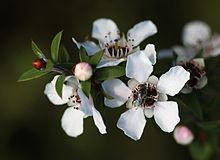- Manuka honey
-
 A native bee visits a manuka flower (Leptospermum scoparium). Manuka honey is made by introduced European honey bees (Apis mellifera).
A native bee visits a manuka flower (Leptospermum scoparium). Manuka honey is made by introduced European honey bees (Apis mellifera).
Manuka honey is a monofloral honey made by bees in New Zealand that frequent the manuka bush, Leptospermum scoparium. Only 10 percent of all Manuka Honey is claimed to have antibacterial properties because of its non-hydrogen peroxide antibacterial content which is known as NPA (Non-Peroxide Activity) Manuka honey. Another popular bio activity testing method is MGO which focuses on the Methylglyoxal content of the honey. MGO is found in high concentrations in Manuka honey and according to German researcher, Professor Thomas Henle, is the antiseptic compound mostly responsible for NPA. Manuka Honey should contain at least 70% Manuka pollen count in order to be called Manuka Honey or NPA Manuka Honey.[1]Manuka honey is typically dark in colour with a strong flavour.[2]
Contents
Origin
Manuka honey is gathered in New Zealand from bees feeding on manuka, which grows uncultivated throughout the country. The honey has antibacterial properties, but its antimicrobial activity varies with origin and processing.[3][Full citation needed]
Antibacterial ratings
An agar-well diffusion assay is conducted on the bacterium Staphylococcus aureus Firstly, two wells are created in an agar plate, and S. aureus cells are scraped onto each well using an inoculating needle. After soaking small squares of blotter paper with methylglyoxal and phenol solution separately into the wells, each square is set in different ends of the agar plate using forceps and then left upside down in the refrigerator for a few days. After that, a comparison between the size and shape of the bacterial colonies is made to determine the antibacterial activities between the two. Varying concentrations of phenol solution are used to find one that coincides with the antibacterial potency. Thus a fair and accurate Unique Manuka Factor (UMF)[4] can be determined.[5]
See also
Notes
- ^ New Zealand Journal of Agricultural Research Volume 28, Number 1, 1985
- ^ Jon Morgan (5 March 2009). "Money from honey - a family affair". Dominion Post. http://www.stuff.co.nz/dominion-post/business/farming/1999278/Money-from-honey-a-family-affair. Retrieved 12 March 2011.
- ^ Peter Charles Molan (Dec 2001). Honey as a topical antibacterial agent for treatment of infected wounds. World Wide Wounds. ISSN 1369-2607.
- ^ "What is UMF® honey?". http://www.umf.org.nz/What-is-UMF-honey. Retrieved August 24, 2011.
- ^ Elvira Mavric; Silvia Wittmann; Gerold Barth; Thomas Henle (2008). Molecular Nutrition & Food Research 52 (4): 483–489. doi:10.1002/mnfr.200700282.
External links
- Honey can reverse antibiotic resistance, study suggest from sciencedaily.com
- What's special about Active Manuka Honey? from Waikato Honey Research Unit website
- Koichi Inoue, Shiho Murayama, Fumie Seshimo, Kazue Takeba, Yoshihiro Yoshimura and Hiroyuki Nakazawa, 2005, Identification of phenolic compound in manuka honey as specific superoxide anion radical scavenger using electron spin resonance (ESR) and liquid chromatography with coulometric array detection
- Ion channel research
- Manuka honey 'could help fight superbugs'
- Activity Testing & Manuka Analysis from Minerva Scientific
Categories:
Wikimedia Foundation. 2010.
